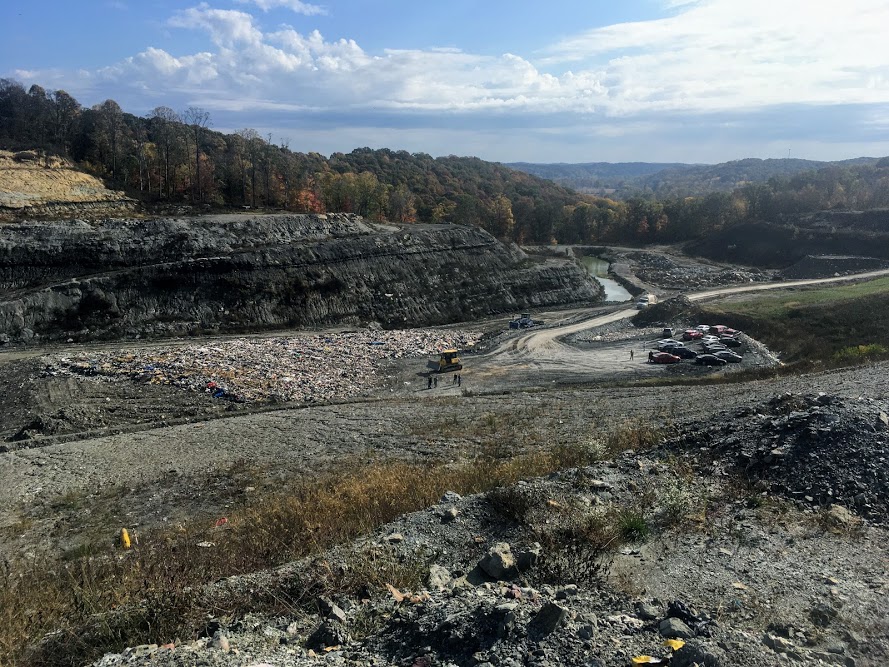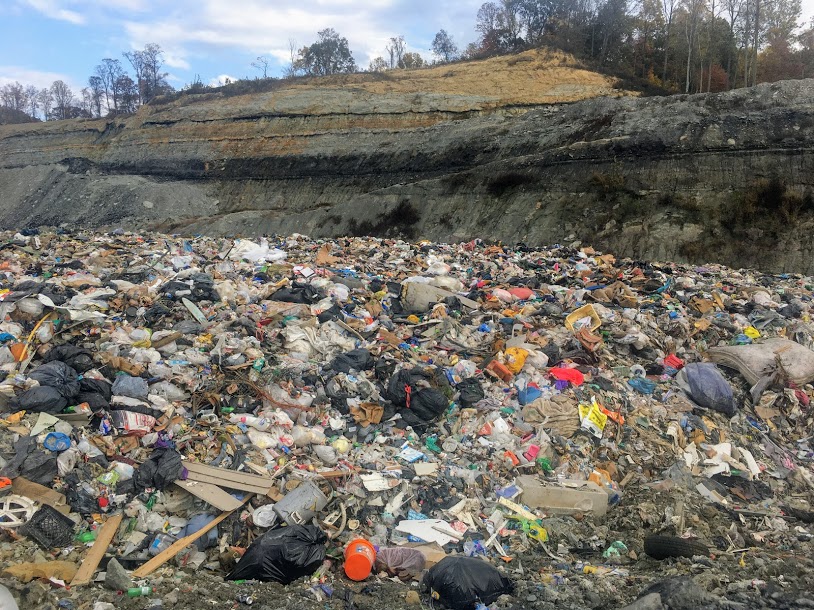
In October, Sophie (another educator with Rural Action) and I went on a “World of Waste Tour” across southeast Ohio. We saw where our waste goes after leaving our bins: a landfill, recycling center, and compost facility. The landfill made a big impression!
Where our waste goes is often a mystery to the average person. The saying “out of sight, out of mind” really applies to what we throw away! Learning about how our waste is handled and how much waste we create helps us reduce our environmental impact.
In this blog post, we share what we learned about landfills: what they are, how they work, and what a landfill looks like here in southeast Ohio.
What is a landfill?
A landfill is a place where we put solid waste. If we can’t turn it something new through recycling or composting, it goes to the landfill. When we throw something in the trash can, it goes to the landfill. It will never be seen or used again. (So think about if something has more uses before you put it in the trash can!)
Today, landfills keep trash separate from the environment around it. However, landfills didn’t always have environmental safeguards in place. Landfills used to just be big holes in the ground full of trash, called open dumps. No one watched out for how that trash might affect water or air.
Certain types of waste are more harmful to the earth and its people than others. Waste that is considered dangerous to human and environmental health is known as hazardous waste. Plenty of hazardous waste ended up in old school landfills.

An old landfill near Nelsonville on 691 used to take hazardous waste. It was not well managed for our protection. The 691 Landfill was open from 1969 to 1984. It covered 30 acres and mainly took trash from households, but a lot of hazardous waste found its way in. The Environmental Protection Agency (EPA) labeled the area a Superfund Site because of all the dangerous waste in it. This fancy name just means the area needed cleaned up as soon as possible.
The EPA and its partners cleaned up the 691 Landfill from 1995-1998. Now, the hazardous waste inside shouldn’t harm us or the natural world. The 691 Landfill looks like this now, with dirt and grass on top of the trash.

Modern landfills
The 691 landfill, like most landfills of the mid-20th century, didn’t have infrastructure in place to lessen the environmental impact of trash rotting in the ground. Today, our waste goes to sanitary landfills.
Sanitary landfills are sites where waste is isolated, or kept separate, from the environment. Professionals in fields like geology, engineering, and environmental science run sanitary landfills. The site supervisor at the Athens Hocking Reclamation Center, the place our trash goes in southeast Ohio, has a bachelor’s degree in geology and a master’s degree in geological engineering. You have to really know your stuff to have a job like this! Supervisors are in charge of making sure their landfills are following federal regulations. The EPA sets these intensive regulations to protect the environment around landfills.
Landfill regulation
According to the EPA, landfills have to be located away from fault lines (cracks in the earth), wetlands, and floodplains.
Paying attention to fault lines when choosing a spot for a landfill will keep us from stirring up trouble with the rock layers that make up the earth when digging out the landfill.
We choose locations away from wet areas to ensure leachate stays far away from our drinking water. Leachate is the liquid trash goop that leaks out of a landfill. Does your trash bag drip when you take it to the curb? Leachate is that same liquid, but on a larger, more toxic scale.
The location of some landfills has sparked controversy, however. Robert Bullard, known as the father of environmental justice, did a study on the location of landfills in Texas. He noted that every landfill in the state is located in mostly black and brown, lower-middle income neighborhoods. Black and brown folks make up only 25% of the population of Texas, but 100% of landfill’s neighbors. Geology and hydrology are major players in the siting of landfills, but there might be political reasons a landfill is where it is.
Regulations now say a landfill needs a geo-membrane to hold that leachate. This is often a two foot (or more) layer of clay on the edges of the landfill. Geo-membranes typically have a plastic liner outside the clay. Geo-membranes and plastic liners keep liquid and chemicals from leaking into the soil and groundwater. Complex leachate collection systems catch and direct leachate away from groundwater. One acre of a leachate collection system costs $250,000!
Watch this video about the layers of a landfill and how it protects the area around it.
Another system in place to ensure the environmental safety of landfills is groundwater monitoring. Underneath the soil, there are holey rocks that hold water in the ground. This is called groundwater. The groundwater around landfills is tested often to see if the water is safe for humans and wildlife.
There are several daily practices used to control the yucky smell, keep trash from flying away, and keep insects and rats out. Every time a truck dumps trash in the landfill, this trash is rolled over multiple times with a compactor. A compactor weighs about 50 tons (that’s 100,000 pounds!) and has giant spiky wheels to grind up the waste. Dirt is placed on top of the trash after it is ground up and compacted to keep water out.
Saying goodbye to a landfill
When a landfill is as full of trash as it can legally be, it needs to be safely closed. A two foot layer of clay and a six inch layer of topsoil to grow native grasses are placed on top of all the trash to close the landfill.

Landfills need to make enough money to pay someone to monitor the landfill for at least 30 years after it stops taking trash! This person will look closely at the effectiveness of the liners and leachate collection systems over time. Is the landfill holding all the leachate? Is the environment around the landfill is contaminated? Continuous monitoring lets us know what methods we use work well and which ones need adjusting. Through ongoing observation of landfills
, we can create sites that are more environmentally friendly in the future.Our local landfill

The Athens Hocking Reclamation Center in Nelsonville is the final destination for trash we put to the curb or in a dumpster. This landfill opened in 1983. Now that the EPA regulates landfills, the Athens Hocking Reclamation Center has to get a permit for the disposal of solid waste, their impact on water and air quality, and for the disposal of leachate that seeps from the landfill. If they aren’t doing enough to protect the air and water, these permits can be taken back and the landfill will be illegal to operate.
This landfill has 3 feet of clay beneath it, as well as a 60 millimeter polyethylene liner (the plastic liner made just for landfills). The clay and plastic together should stop trash from leaking into the soil below and contaminating it. This landfill does not have a collection system for the methane gas that is created by decomposing trash. The landfill releases methane into the air, but methane is a powerful greenhouse gas that contributes to climate change. Landfills can have local impacts on air and water quality, but they also add to global climate change if the methane is not collected.
Our local landfill is 550 acres large. It’s estimated that this landfill has 50 years of trash disposal left in it. Then it will be full. According to the environmental director of the landfill, there are 11,000,000 yards of capacity left. Each day, the landfill sees about 50 to 75 trucks of household waste. Add all of those trucks up, and the landfill receives 70,000 tons of household waste a year. That’s on top of the waste they take from industry!
The trash that comes in on trucks each day is unloaded onto the daily face. This is the section of the landfill that they chose to put trash on that day. A worker runs over the daily face with a compactor at least 6 times to push the trash down as much as possible. At the end of the day, workers cover the new trash with six inches of dirt to prevent water from leaking into the trash and to keep the flies and rats down. You saw the compactor running over trash at our landfill earlier!

It was sad to see so many usable items be smashed by a giant compactor. We saw plastic chairs, a dollhouse, a basketball, and many other items that looked like they were in good shape be run over and buried. Eugene and I even found a frisbee to play with!
While landfills are designed to be the safest method for disposing of things that truly are trash, I don’t think most of the things I saw in the landfill deserved to be there. These items could have lived many more lives. Instead
, they are now buried in a mound of dirt in an area that was once a stunningly pretty valley.What can we do?
If you read this blog post and thought “Gee, landfills don’t sound all that great,” and would like to learn more about keeping your waste out of landfills, check out our previous blog posts about waste.
Seeing a landfill and feeling all the trash shake under my feet when a machine drove by was an upsetting experience, but it has opened my eyes to just how much unnecessary trash we make in this world.